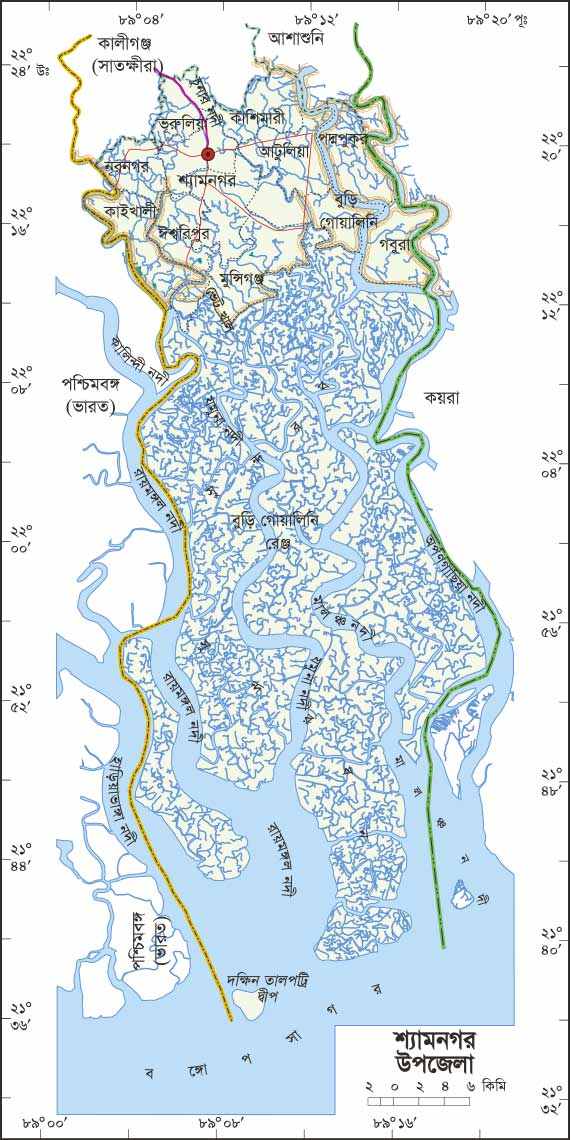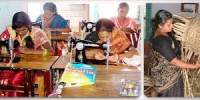1.1Preface
Satkhira district came into being in 1984 as a full pledged district had created out of greater Khulna district. It is one of coastal district where biggest mangrove forest of the world the Sundarban is situated. 70% of our total fish comes, and 90% of export earnings from frozen foods comes from Satkhira and this the place where the bread basket of Bangladesh is situated
Unfortunately, this potential and important area has been experiencing changes of physical environment and the socio- economic phenomena with the expansion of shrimp culture. In agriculture once Satkhira district was famous for its crop production. Particularly this district is self sufficient in respect of food production. Total area of the district is about 3750 square kilometer. Different rivers namely Ichamoti, Kalandi, Batraboti, Kopadakka, Raymongal, Morirchappa, Kulpatua and Kaschiali rivers are flowing over the vast territory of the district. In the south to the district huge area of the Sundarban mangrove forest caused monsoon climatic affect which once caused enough rainfall. But due to climate changes and recently happened Aiala and Sidar the physical environment of the district has been devastated enormously.
We the team of eight Officers from Advanced Course of Administration and Development (ACAD) visited Satkhira district and Shamnagar Upazila intensively and tried to find out the causes and extend of physical environment changes and social- economic impacts of shrimp culture. During our study tour the District and Upazilla administration extended all out support and cooperation for the success of the study visit. Along with them local social leaders and different leaders of National Shrimp farmers Association and local NGO especially SHUSHILON also extended whole hearted cooperation to the success of our study visit.
We the team members were also pleased to have guidelines from our Course Director during our field visit. In our study report we intended to focus the opinion of the local stakeholders as regard the physical environment and socio economic changes of the area we visited. We also mentioned in the report our recommendations to face the challenges of changes over the physical environment and socio- economic changes of Shrimp cultivation
1.2 Introduction
Satkhira district is situated in the south east corner of the country with the tidal flow of the Bay of Bengal. Over the terrain of the district there are four rivers flowing namely Morirchappa, Batna, Shalika and Kopatacha among them 100% navigability of the river morrichappa has been eroded and other rivers has also lost the substantial amount of water flow.
Satkhira district has about 18 lac population. In every year this district has met the demand of fish in the district and supplied about 20 thousand tons of fish to the other part of the country. In the district there has been some damage in cereal production due to increasing shrimp cultivation in agricultural saline belt. Total area of the district is about 3 lac 75 thousand hectare and area of arable land is about 1 lac 39 thousand 8 hundred hectare. Total land area of shrimp culture is about 54 thousand 5 hundred and 86 hectare. Total demand of food is about 3 lac 65 thousand 340 metric tons and total food production is about 6 lac 52 thousand 737 metric tons having a surplus of about 2 lac 45 thousand 91 metric tons. In the district total saline affected agricultural land is about 1 lac 88 thousand 896 hectare against that shrimp cultivation has covered about 54 thousand 586 hectare of land. From the early time of eighteen decade unauthorized cutting of barrage and unplanned intrusion of saline water has been increased and consequently some unscrupulous people started shrimp cultivation. In all over the district about 25 thousand shrimp Gar has been established in about 54 thousand hectare of agricultural land in saline water.
On the other side shrimp export has constituted about 2.4% of the total export of the country. More than 10 lac people are directly involved in this sector. From the Satkhira district in 2008-09 FY 1 (One) thousand 160 crore taka earned out of export of shrimp. There have been some problems of shrimp cultivation in the district. Virus free fry and timely availability of saline water and other lacking of physical infrastructure and lack of appropriate training, unplanned cultivation causing less production and also harming the physical environment of the locality. Identification of suitable area for shrimp cultivation and declaring zoning system in the shrimp production is the demand of the district as we found during our study period.
2.2 Map of Shamnagar Upazila

2.3 TITLE OF THE STUDY
Physical Environment and Socio- Economic Impact of Shrimp Cultivation
2.4 FOCUS AREA OF THE STUDY
This study has been meant to assess the impact of the physical environment of the Shamnagar Upazila and socio economic impact of shrimp cultivation in Satkhira District
2.5 IDENTIFICATION OF STUDY TEAM
The name of the members who worked for the study visit is shown below:
Sl. No. | Name | Designation | Current Position |
| 1 | Md. Abul Kashem Talukder | Deputy Secretary | Ministry of Health and Family welfare |
| 2 | Matiur Rahman | Deputy Secretary | Finance Division |
| 3 | Md. Mohsinul Alam | Deputy Secretary | Post and Telecommunication Ministry |
| 4 | Nanda Dulal Banik | Commercial Manager (Deputy Secretary) | Chittagong WASA |
| 5 | Md. Jahangir Alam | Director (Deputy Secretary) | IMED |
| 6 | Tulashi Ranjan Saha | Additional Deputy Commissioner(Deputy Secretary) | Kishoregong |
| 7 | Ratan Kumar Sarkar | Additional Chief Mechanical Engineer (Deputy Secretary) | East(DS), CRB, Chittagong |
| 8 | Commander Shahid Mahmud | (L) BN (PNo-795 DMP( Odnance) | BN Dockyard, New Moring, Chittagoing |
3.1PURPOSE OF THE STUDY
To visit the Satkhira district and Shamnagar Upazila to assess the extend of the changes of the physical environment and to meet the local people and social leaders to have the opinion and to measure the trends of changes and affect of socio-economic phenomena of the saline belt areas of the Upazila and district in the increasing volume of shrimp cultivation in the study area
3.2 Methodology of the Study
The methodology, which we followed during the study are as follows:
a) Interview (get first hand feedback)
b) Focus Group Discussion (Obtain View)
c) Meeting
d) Observation
e) Data collection (Direct Interview & Perusing Registers)
f) Data analysis
The team met Deputy Commission, Satkhira and District Fisheries Officer and held a meeting with different class of people.
The team also met Deputy Director Agricultural Extension and through perusal of records regarding crop production and rainfall trend in the district. The team conducted a Focus Group Discussion in the conference room of Shamnagar Upazila Parisad and exchange views with Upazila Nirbahi Officer, Upazila Fisheries Officer, Upazila Agriculture Officer, NGO representatives, Shrimp farmers, Press, local leaders, public representatives, leader of Shrimp Cultivation Association representatives.The team visited and observed the Shrimp Culture Project namely Gabura Shrimp Culture Project and Burigoalini Shrimp Cultivation Project and observed the cultivation and took interview of the local people and obtained field data. The detailed action taken by the team and findings are mentioned below:
3.3 Met Deputy Commission, Satkhira and obtained related facts and figure of Shrimp culture of Satkhira districts and environmental affects of man made problems:
- During the meeting with Deputy Commissioner other high level government official and District Fisheries Officer also were present. Through interview the team obtained the following comments made by the Deputy Commission.
- Satkhira district is the coastal district and salinity intrusion has been very high and shrimp cultivation with unplanned manner increased the problem at an alarming rate
- There has not been flow of water from upper stream and there is no preserver for holding flood water so surface water salinity has been increasing
- There are about 215 ponds in Satkhira district could be made well protected with raising its boarder to neutralize the salinity
- There should be enough arrangement for keeping rain water
- Water logging has been the severe problem in the district so re excavation of derelict canals and rivers be done on an emergency basis
- In the district there has been attempt to excavate the Jamuna River to preserve the rain water
- Excavation of Kopattakha River could be helpful to bring upper stream and gradually reduce the salinity of the surface water
- To redress the problem of severe water logging marinating free tidal follow could be the appropriate technology this method is named as “ Tidal Water Management (TRM)”
- As many as natural reservoir of water should be made to contain free water
- Local people has been pauperized due to the long time water congestions of their land
- Drainage problem has been acute
- Health service and educational activities are also affected for water congestions
- Without continuous maintenance switch Gates has created barrier for water drainage
- For shrimp cultivation local canals are obstructed with artificial barriers and created unplanned infrastructure causing natural water flow obstructed
- A good number of local poor people are forced to migrate for not having alternate profession of agriculture
3.4 Visited District Fishery Office:
The team meet District Fishery Officer and perused the available secondary records on the physical environment and socio economic impacts of shrimp culture
In 2008-09 year the export of shrimp has been reduced to about 15% in volume comparing to the export of 2007-08 because of low quality production and production hampered by natural disaster like Aiala and cyclone.
Shrimp Production in Khulna Region
| Financial Year | Quantity of Frozen Fish | Income from Export |
| 2006-07 | 45731 KG | 2295.00 Crore Taka |
| 2007-08 | 40001 KG | 2000.00 Crore Taka |
| 2008-09 | 41485KG | 2016.00 Crore Taka |
| 2009-10( Upto Dec/2010 | 22388KG | 1057.00 Crore Taka |
Export of Shrimp from Satkira District
Financial Year | Export Earning in Taka ( Crore) |
2006-07 | 1150 |
2007-08 | 1230 |
2008-09 | 1160 |
- Main problems of shrimp cultivation are non availability of virus free fish fry, non availability of fry at right time, not having required depth of water in the field, not having opportunity to change water frequently as required, lack of appropriate training of the workers engaged in the cultivation process
- Derelict river and pond are not re excavated to have water is also causes of not expanding the shrimp farms on profitable basis
- There is no any comprehensive Shrimp Policy of the government for want of it management of the sector faces problem
- Identification of shrimp cultivation area and declaring specific zone for the cultivation is very urgent demand of the locality
- Virus free shrimp fry should be produced at cheaper price and ensure the production and marketing of the same properly
- All the switch gates should be well maintained and all other infrastructure be developed by the Water Board so meticulously to ensure the availability of water to all cultivation spot uninterruptedly
- Embankment height should be raised up to 20 feet and wide should be kept 25-30 feet and ground should be as accordingly 60-100 feet to make it stronger
- Mangrove forest could be raised on the both side of the embankmentv All the committee formed by the government in regard shrimp cultivation should work actively
- All other necessary infrastructure should be built by the government with the earning of shrimp export
- PCR lab maintenance guideline should be formulated properly and it should be implemented
- Proper conservation of naturally available shrimp fry sources be ensured
- Effective control should be implemented on offshore area to ensure the conservation, preservation and exploitation of shrimp
- Appropriate research initiative could be strengthen to ensure environment friendly cultivation of shrimp
- Research, total quality control and extension activities should be strengthen
4.4 Visited District Agriculture Office:
The team visited district agriculture office and identified the agricultural production and the magnitude of affects to salinity of the locality causing enormous environmental effects. The secondary data available in the office are perused and are furnished below in the following categories (In hectare)
In 2009-10 the particulars of Saline Area of Shatkira District
(In hectare)
Total Cultivable Land | Area under Cultivation | Shrimp Area | Shrimp Area under Cultivation |
188896 | 135000 | 54586 | 10120 |
Since the early eighties in the coastal belt of the district some unscrupulous people leaked the embankment unauthorized and withdrawn saline water through breaking embankment and cultivated shrimp in a unplanned way. That affects the production of rice in the area. The increasing trend of salinity is mentioned below
Year wise increase of salinity in Shamnagar Upazila (PPT)
Month 2006 | 2007 | 2008 | 2009 | 2010 |
January 13 | 12 | 11 | 12 | 14 |
February 15 | 14 | 13 | 14 | 15 |
March 17 | 16 | 15 | 18 | 20 |
April 21 | 20 | 21 | 19 | 25 |
May 26 | 25 | 24 | 30 | |
June 28 | 27 | 26 | 32 | |
July 23 | 22 | 20 | 28 | |
August 12 | 11 | 10 | 26 | |
September 07 | 06 | 08 | 24 | |
October 08 | 07 | 09 | 24 | |
November 10 | 09 | 10 | 13 | |
December 12 | 11 | 10 | 14 |
Source: Upazila Fisheries Office, Shamnagar, Satkhira
Year Wise Record of Rainfall in Satkhira District(MM)
1996 | 1997 | 1998 | 2008 | 2009 2010 |
1717 | 2082 | 1748 | 1403 | 1339 888 (August/10) |
Source: District Agriculture Office, Satkhira
Observations as regards affects on agriculture
- Due to shrimp cultivation salinity in the soil has been increasing and agricultural production hampered
- Production of transplanted Aman in Shamnagar upazila has decreased for salinity of the soil
- Vegetable production has also decreased and consequently nutrition level has been going down
- Soil fertility is diminishing
- Agricultural land has decreased and employment in the sector gone down
- Old trees has been dying gradually on the bank of shrimp cultivation
- Grazing land for cattle has decreased and rearing animal become difficult
- Drinking water scarcity wide spread
- Guidelines for planned shrimp cultivation should be introduced
- Saline tolerable paddy could be cultivated
- Strong embankment should be raised and plantation could be made around the barrage to make green belt
- Water preservation should be made for drinking and sinking of deep tube well be the way to provide safe source of water to the people
5. Exchange of opinion with National Shrimp Farmer Association
- Team members met Dr. Aftabuzzaman, President of National Shrimp Farmers Association and Dr. Abul kalam Babla, Secretary, Shatkhira Shrimp Farmers Associaton at Shatkhira Circuit House Conference Room. ADC (General), Satkhira was also present during discussion. Through interview the following observations could be made as follows:
- Shrimp cultivation is taken place in the arable land. Shrimp is a permanent crop so changes of land ownership is happening which not encourage forestation of the area.
- Problems of drinking water has been acute but not for shrimp but due to increase of salinity of the water and public health is also endangered
- Before flourishing the shrimp cultivation in many case due to other problem many land owner could have to starve for meager agricultural production
- Level of saline intrusion in the area has been evident less quantity in early time
- Most of the tributaries and rivers has dried and up stream flow of water have been stranded consequently salinity of the surface water has increased more than tolerable level which helps to facilitate shrimp cultivation in the area
- National shrimp policy is the final stage of formulation at national level where indigenous knowledge would be preferred in shrimp cultivation as well as preserving environmentv Organic aquaculture in the coastal area may be a new dimension to capture the export market in a sustainable way as the market of organic products are expanding rapidly in recent year with organically farmed aquatic products earning premium prices over conversational products-specially shrimps
- Area of shrimp culture not only produce shrimp but with this 72% -75% area are used for aqua culture
- Shrimp produced in the locality broadly are based on traditional system. Average production is 300 Kg per hectare. Shrimp fry is artificially stocking before cultivation. Salinity required for fry production is about 32 PPT.
- In early period there was abundance of fry in the rivers. Now most of the rivers are dried up and people indiscriminately catch the fry from rivers and caused harmed to other fish fry consequently total biological chain has been devastated
- Normally and ideally a fertile soil should contain 3.5% to 4% organic matter. Lack of flooding by river water, little or no vegetative growth during dry season and overgrazing of the land minimizing the organic content. Thereby fertility is loosing
- Since 193-94 shrimp fry was imported from Thailand and in 1995 viral problem detected in shrimp farm caused huge losses to the fish farmers
- Over the years changed reverine system and hydro-morphological condition resulting higher salinity content and greater salutation in the estuarine area seriously affected the flora and fauna of the sundarban forest
- The natural aorestation process has been greatly reduced and many varieties of commercially important trees and shrubs are vanishing fast
- There has been substantial changes on soil fertility due to increase of salt content on the top soil
- It is also evident that changes have taken place on rural economy and social structure. Fishermen got greatest blow whose percentage was around 12-15%. Destruction of captured fisheries forced many of them either to change to other profession or to migrate.
- The Mat or Madur weaver and the “goala” had to change their profession. Powder milk has taken the place of cow milk
- Paddy-cum-fish cultivation may be recommended in areas where it is possible in the locality
- Bangladesh is a newly formed landmass. It has been created out of silt coming from Himalayas. Had not there been no flood in Padma, Megna, Jamuna and Brahmaputra, there would be no golden Bengal. This process of land formation should be kept uninterrupted.
- To overcome the problem of water congestion massive sluice gate and massive mechanical pumps could be used by the government
- Aqua culture or shrimp culture does not hamper transplanted aman cultivation
- Rate of production of local variety of T. Aman is rather high within the shrimp “gher” than the other area where no such aquaculture practice is done
- The soil salinity was comparatively low on the shrimp field than the other areas where no aquaculture practice was done
- A major portion of many areas of Satkhira district could be utilized for “ Fish- cum-Paddy” cultivation getting higher return rather than very low retun with only one crop
- Immediately a detailed survey of the coastal area be made and the extend of environmental biological and ecological damage be documented
- An immediate survey be made and prospective “ Fish cum Paddy” cultivable areas be identified and declared for the purpose, i.e land use policy must be declared
- Unplanned construction of new embankment, dykes, roads or any other infrastructure be avoided
- All the government owned canal be surveyed and documented and be broad under comprehensive management
6. Exchange of opinion and Focus Group Discussion (FDG) with local people in Upazila Conference Hall, Shamnagar:
- The team members participated meeting at Shamnagar Upazila Hall room attended by concerned government officials, local representatives, shrimp farmer, political leaders, press and NGO representatives. The findings of the discussion are mentioned below:v In early time shrimp was available naturally. Now due to increase the salinity of water the fresh water fishes are also affected with numerous diseases. Fish fry without virus infection are not easily available and cost of production are increasing because of not having easy credit to the farmer
- Embankment was erected in sixties decade before that sea water flows was open. In eighties shrimp cultivation started. Since 1994 fish fry has been become scarce. Import of fry started at that time and virus infection has been detected alarmingly.
- In the Upazila 220 kilometer embankment has been constructed by Water Board. In distant from 5 Kilonmeter from Upazila salinity has been found. Production of paddy has been decreased and rainfall is decreased.
- Climate changes need adaptable technology and root level people could be involved in policy making process to overcome the issue
- Shrimp culture expanded more than agricultural land and arable land is decreased. In some places water congestion aggravated the suffering of the local people. Land use plan with zoning for shrimp cultivation should be introduced for caring environment
- Rate of migration to urban place are increasing day by day as agriculture profession is losing
- Bio-diversity has also been affected in mangrove forest and adjacent area
- Salinity is rising unto PPT 35 in some places. Canal and water bodies are during up so drainage problem occurred severely. Unauthorized perforation of barrage by some people caused environmental hazard
- Salinity was the feature evident from early time. Local variety of fishes decreased due to use of pesticides indiscriminately
- Crab farming may be the lucrative profession and that can be encouraged among people as alternative employment
- Shrimp cultivation can be transformed into closed system as semi automated instead of conventional system
- Grazing land for cattle be preserved for domestic animals
- Shrimp cultivation is not a labor intensive process so diversity of profession for unemployed people be created
4.1 Recommendation:
With in-depth observation, interview, perusing secondary data and focus group discussion on the issue physical environment and socio-economic impacts of shrimp cultivation the team has accumulated some recommendation to address the problem. The recommendations are mentioned below:
Satkhira district is the coastal district and salinity intrusion has been very high and shrimp cultivation with unplanned manner increased the problem at an alarming rate. There has not been flow of water from upper stream and there is no preserver for holding flood water so surface water salinity has been increasing.There are about 215 ponds in Satkhira district could be made well protected with raising its boarder to neutralize the salinity
There should be enough arrangement for keeping rain water
Water logging has been the severe problem in the district so re- excavation of derelict canals and rivers be done on an emergency basis. In the district there has been attempt to excavate the Jamuna River to preserve the rain water
Excavation of Kopattakha River could be helpful to bring upper stream and gradually reduce the salinity of the surface water
To redress the problem of severe water logging marinating free tidal follow could be the appropriate technology this method is named as “Tidal Water Management (TRM)”
As many as natural reservoir of water should be made to contain free water
Local people have been pauperized due to the long time water logging of their land. Drainage problem has been acute .Health service and educational activities are also affected for water logging. Without continuous maintenance switch Gates has created barrier for water drainage. For shrimp cultivation local canals are obstructed with artificial barriers and created unplanned infrastructure causing normal water flow obstructed. Unplanned infrastructure construction should be avoided
A good number of local poor people are forced to migrate for not having alternate profession of agriculture. Shrimp cultivation is not a labor intensive process so diversity of profession for unemployed people be created
Main problems of shrimp cultivation are non availability of virus free fish fry, non availability of fry at right time, not having required depth of water in the field, not having opportunity to change water frequently as required, lack of appropriate training of the workers engaged in the cultivation process. Backward and forward linkage economic activities should be created for growth of the sector
Derelict river and pond are not re- excavated to have water is also causes of not expanding the shrimp farms on profitable basis. Government should immediately re- excavate the dead river and canal and should keep regular maintenance of re- excavation
There is no any comprehensive Shrimp Policy of the government for want of it management of the sector faces problem. Root level peoples should be involved in preparing the shrimp policy and implementation of the policy
Identification of shrimp cultivation area and declaring specific zone for the cultivation is very urgent demand of the locality
Virus free shrimp fry should be produced at cheaper price and ensure the production and marketing of the same properly
All the switch gates should be well maintained and all other infrastructure be developed by the Water Board so meticulously to ensure the availability of water to all cultivation spot uninterruptedly
Embankment height should be raised up to 20 feet and wide should be kept 25-30 feet and layer should be as accordingly 60-100 feet to make it stronger
Mangrove forest could be raised on the both side of the embankment
All the committee formed by the government in regard shrimp cultivation should work actively
All other necessary infrastructure should be built by the government with the earning of shrimp export
PCR lab maintenance guideline should be formulated properly and it should be implemented
Proper conservation of naturally available shrimp fry sources be ensured
Effective control should be implemented on offshore area to ensure the conservation, preservation and exploitation of shrimp
Appropriate research initiative could be strengthen to ensure environment friendly cultivation of shrimp
Research, total quality control and extension activities should be strengthen
Guidelines for planned shrimp cultivation should be introduced
Saline tolerable paddy could be cultivated
Strong embankment should be raised and plantation could be made around the barrage to make green belt
Water preservation should be made for drinking and sinking of deep tube well be the way to provide safe source of water to the people
In early period there was abundance of fry in the rivers. Now most of the rivers are dried up and people indiscriminately catch the fry from rivers and caused harmed to other fish fry consequently total biological chain has been devastated. Normally and ideally a fertile soil should contain 3.5% to 4% organic matter. Lack of flooding by river water, little or no vegetative growth during dry season and overgrazing of the land minimizing the organic content. Thereby fertility is loosing. Appropriate technology should be implemented to address the issue
Since 1993-94 shrimp fry was imported from Thailand and in 1995 viral problem detected in shrimp farm caused huge losses to the fish farmers. Virus free fry should be made available to the door step of farmer
Over the years changed reverine system and hydro-morphological condition resulting higher salinity content and greater salutation in the estuarine area seriously affected the flora and fauna of the sundarban forest. The natural aorestation process has been greatly reduced and many varieties of commercially important trees and shrubs are vanishing fast. There have been substantial changes on soil fertility due to increase of salt content on the top soil. Bio diversity should be preserved at any cost
It is also evident that changes have taken place on rural economy and social structure. Fishermen got greatest blow whose percentage was around 12-15%. Destruction of captured fisheries forced many of them either to change to other profession or to migrate. Enough employment should be created
The Mat or Madur weaver and the “goala” had to change their profession. Powder milk has taken the place of cow milk. Diversity in profession could be the solution to the problem
Paddy-cum-fish cultivation may be recommended in areas where it is possible in the locality
Bangladesh is a newly formed landmass. It has been created out of silt coming from Himalayas. Had not there been no flood in Padma, Megna, Jamuna and Brahmaputra, there would be no golden Bengal. This process of land formation should be kept uninterrupted.
To overcome the problem of water congestion massive sluice gate and massive mechanical pumps could be used by the government
A major portion of many areas of Satkhira district could be utilized for “ Fish- cum-Paddy” cultivation getting higher return rather than very low return with only one crop
Immediately a detailed survey of the coastal area be made and the extend of environmental biological and ecological damage
In early time shrimp was available naturally. Now due to increase the salinity of water the fresh water fishes are also affected with numerous diseases. Fish fry without virus infection are not easily available and cost of production is increasing because of not having easy credit to the farmer. Sound policy is required to solve the problem.
In the Upazila 220 kilometer embankment has been constructed by Water Board. In distant from 5 Kilonmeter from Upazila salinity has been found. Production of paddy has been decreased and rainfall is decreased. Climate changes need adaptable technology and root level people could be involved in policy making process to overcome the issue
Shrimp culture expanded more than agricultural land and arable land is decreased. In some places water congestion aggravated the suffering of the local people. Land use plan with zoning for shrimp cultivation should be introduced for caring environment
Rate of migration to urban place are increasing day by day as agriculture profession is losing. Bio-diversity has also been affected in mangrove forest and adjacent area. Salinity is rising unto PPT 35 in some places. Canal and water bodies are during up so drainage problem occurred severely. Unauthorized perforation of barrage by some people caused environmental hazard that should be stopped immediately
Crab farming may be the lucrative profession and that can be encouraged among people as alternative employment
Shrimp cultivation can be transformed into closed system as semi automated instead of conventional system
Grazing land for cattle be preserved for domestic animals in the locality
4.2 Conclusion:
Shrimp cultivation is a flourishing sector with tremendous prospect for the country. Through solving the problem of the shrimp farmer and adapting appropriate technology production rate from 300 KG per hectare to 1000 KG per hectare. Shrimp cultivation can be broadening into the fresh water pond through out the country and the national production could have been enhanced. There has been a good prospect of employment for huge people. A comprehensive shrimp policy should be formulated immediately to address the issues of the sectors.
Satkhira district is the coastal district and salinity intrusion has been very high and shrimp cultivation with unplanned manner increased the problem at an alarming rate. There has not been flow of water from upper stream and there is no preserver for holding flood water so surface water salinity has been increasing. There are about 215 ponds in Satkhira district could be made well protected with raising its boarder to neutralize the salinity.
To redress the problem of severe water logging marinating free tidal follow could be the appropriate technology this method is named as “Tidal Water Management (TRM)”. As many as natural reservoir of water should be made to contain free water. Local people have been pauperized due to the long time water logging of their land. Drainage problem has been acute .Health service and educational activities are also affected for water logging. Without continuous maintenance switch Gates has created barrier for water drainage. For shrimp cultivation local canals are obstructed with artificial barriers and created unplanned infrastructure causing normal water flow obstructed. Unplanned infrastructure construction should be avoided.
There is no any comprehensive Shrimp Policy of the government for want of it management of the sector faces problem. Root level peoples should be involved in preparing the shrimp policy and implementation of the policy. In our short study tour the team successfully assessed the changes of physical environment and socio- economic impacts of shrimp cultivation harnessed the recommendations identified as the outcome of the study in the report. With involving local grass root people a comprehensive action plan should be taken by the government to address the issue and create a congenial atmosphere to both augment the production of shrimp and caring the environment as well.
















